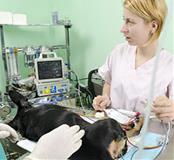4 Considerations When Choosing an Anesthesia Monitor

The importance of proper patient monitoring, especially during anesthetic procedures, is well known. But how do you know what vital signs you should be monitoring and what patient monitor is the best for your practice? Here are some of the most important considerations when selecting a vital signs monitor.
The ACVA recommends monitoring Blood Pressure, CO2, SpO2, ECG/HR, and Temperature. Choose a monitor that offers all of these parameters in a single model to reduce clutter and ensure continuity during the anesthetic procedure. While there are many monitoring options available, here are a few key areas to focus on in selecting the best option for your practice.
Monitoring Blood Pressure
Hypotension can be a common problem in veterinary surgeries, so it’s very important to monitor blood pressure during every anesthetic procedure. While direct arterial blood pressure is the most accurate, most clinics aren’t equipped to monitor invasive blood pressure on every patient. Modern non-invasive techniques can provide accurate and reliable readings. Oscillometric blood pressure technology is easier to use than other non-invasive techniques and can be timed to take measurements at selected intervals, giving you a reading automatically throughout the procedure. It is important to verify, however, that the monitor you choose has been validated in dogs and cats and has veterinary-specific algorithms and alarm limits, since many monitors were developed for the human market.
Monitoring EtCO2 can be an early warning system that can alert you to a host of problems with your patient and/or anesthesia equipment. Quickly gaining in popularity, Et CO2 monitoring is the only practical way to detect the effects of hypoventilation and can be an indication of complications before they occur. When choosing an anesthesia monitor, EtCO2 is a must! While mainstream and sidestream sampling methods both have advantages and disadvantages, look for a technology that is accurate at low flow rates, durable and low-maintenance.
Where will you use it?
You need to evaluate how versatile a system your practice needs. While some clinics prefer to have dedicated systems for each surgery or dental table, many clinics like the flexibility of having a monitor that can move throughout the clinic. Determine what workflow you expect, and then evaluate the mounting and rolling stand options the manufacturer offers to see what the best fit will be for you.
How easy is it to use?
As with all new equipment and technology equipment in particular, ease of use goes a long way in determining how much value you’ll really get from your investment. You don’t want to have a piece of equipment that is so difficult to use that it never leaves the shelf. You really want to focus on the process of booting up, setting up a patient, navigating menus and adjusting alarms, and exporting the data for analysis after the procedure. Features like custom profiles for individual doctors and a touch screen display go a long way toward improving the efficiency of every anesthetic procedure. Every efficiency gain translates favorably to the bottom line.
Questions to ask your Covetrus rep to help determine what monitor is the best fit for your practice
While often overlooked, some of the most important factors to consider when investing in a vital signs monitor are quality, upgradeability, and support. While these factors can be difficult to pinpoint, some good questions to ask are:
- Is the monitor made by a proven and reliable manufacturer that conforms to ISO 13485 standards?
- What is the warranty and does the manufacturer provide free clinical support during and after the warranty period?
- Does the manufacturer have trained veterinary technicians on staff and provide comprehensive training materials?
- Does the monitor have the ability to have its software updated in the field? Are service loaners available?
- Are its accessories cross-compatible with other monitors in the same line or other common accessories on the market?
- Does the monitor use proven technology? Does the brand have a reputation for quality?
- Is there a university or referral site who can recommend a certain brand?
- Can I demo the monitor in my clinic free of charge?
These are all serious considerations when selecting the monitor that will be the best value to your practice. With vital signs monitors, the overarching theme should be quality, accuracy, reliability, ease of use, and support.
For more information, browse our equipment line and don’t hesitate to talk to your Covetrus rep for a recommendation or call 855.724.3461 today!
Need Regulatory Assistance
If you need help with regulatory or licensing issues, we're happy to help. We have a wide variety of resources to help you when issues arise.

Careers
Are you looking for a place to let your talents shine? At Covetrus, we help our practitioner customers better serve their patients and take pride in providing the best customer experience possible. Search our open positions to see our available opportunities.
Newsletter
Stay current with what’s going on with Covetrus, subscribe to receive our newsletter and email communications. Subscribers will receive the latest information in practice management, sales and marketing, animal health, and more.


Leave a comment